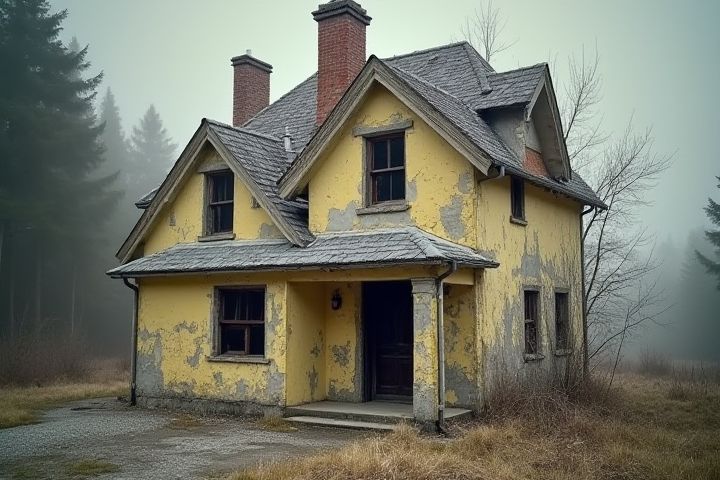
House mold typically appears as uneven patches of varying colors, including green, black, white, or even orange. The texture can range from fuzzy or slimy to powdery, depending on the type of mold and moisture levels in your home. You might notice it growing in damp areas, such as bathrooms, kitchens, or around windows, often accompanied by a musty odor. Mold thrives on organic materials like wood, drywall, and fabrics, creating health risks like respiratory issues if left untreated. Regular inspection and moisture control are essential for maintaining a healthy indoor environment and preventing mold growth.
What House Mold Looks Like
Black or dark green spots
Black or dark green spots on surfaces often indicate the presence of mold, specifically types like Stachybotrys chartarum or Aspergillus niger. These spots typically appear as irregular-shaped patches, often moist or fuzzy in texture, and can vary in size. You may notice them on walls, ceilings, or in areas with high humidity, such as bathrooms or basements. Mold can also emit a musty odor, further signaling its presence and the need for prompt removal to protect your health and home structure.
Musty odor
House mold commonly appears as black, green, or white patches on various surfaces, including walls, ceilings, and floors. Often accompanied by a musty odor, this distinctive smell can indicate hidden moisture problems and potential health risks, making it essential to identify and address the source. You might notice a fuzzy texture or slimy appearance, especially in damp areas like bathrooms and basements. Recognizing these visual and olfactory signs can help ensure a healthier indoor environment and prevent further mold growth.
Fuzzy texture
House mold often appears as a fuzzy or cotton-like texture on surfaces, typically in colors such as green, black, or white. This fuzzy appearance is due to the growth of fungal hyphae, which can form dense colonies on damp materials like wood, drywall, or fabric. You might notice these fuzzy patches in areas with high humidity, such as bathrooms or basements, and they can vary in size from small specks to large clumps. Recognizing fuzzy mold is essential for prompt remediation, as it can pose health risks and indicate moisture problems in your home.
Damp or humid areas
House mold commonly appears as irregular patches or spots with colors ranging from black, green, or white to even orange or pink, thriving predominantly in damp or humid environments. In areas like bathrooms, basements, and kitchens, you may notice fuzzy or slimy textures, often accompanied by a musty odor that indicates moisture accumulation. Mold thrives on organic materials such as wood, drywall, and fabric, making your home more susceptible to infestations if these conditions persist. Regularly checking for leaks, controlling humidity levels, and improving ventilation can help mitigate mold growth and protect your living space.
Growth on walls or ceilings
House mold often appears as dark green, black, or white patches growing on walls or ceilings, typically thriving in damp areas with little ventilation. It may present with a fuzzy or slimy texture and could have a musty odor, indicating excessive moisture levels in the environment. In some cases, you might notice discoloration around windows, water stains, or peeling paint, which are signs of underlying mold growth. Regular inspection and proper moisture control are essential to prevent mold from spreading in your living spaces.
Stains or discoloration
House mold typically appears as fuzzy or slimy patches in various colors, including black, green, yellow, or white. Discoloration often manifests as dark spots or stains on walls, ceilings, or floors, indicating moisture presence and potential growth areas. You may notice uneven texture; mold can create a raised surface that feels different from surrounding materials. Timely identification and remediation are crucial to prevent health issues associated with mold exposure.
Spread in irregular patterns
House mold typically appears as fuzzy or slimy patches with a variety of colors, including green, black, white, or yellow. It often spreads in irregular patterns, creating splotches that can vary in size, resembling stains on surfaces such as walls, ceilings, or even wood. The growth can occur in damp or humid areas, often in corners or around leaks, where moisture facilitates its proliferation. Identifying mold early is crucial, as it can pose health risks and indicate underlying moisture problems that require attention.
Peeling or bubbling paint
Peeling or bubbling paint is a common indicator of house mold growth behind walls or ceilings. This condition typically arises when excess moisture seeps beneath the paint layer, creating a conducive environment for mold spores to thrive. You might notice irregular patches of discoloration under the peeling areas, which can range in color from greenish-black to white, showcasing common mold varieties. Addressing the underlying moisture issue promptly is crucial to prevent further mold proliferation and to protect your home's structural integrity.
Water-damaged spots
Water-damaged spots often appear as dark, irregularly shaped patches on walls, ceilings, or floors, typically ranging in color from black to greenish or brown. These molds may have a fuzzy or slimy texture, indicating moisture accumulation. You might notice musty odors accompanying these visible signs, which can be a clear indication of underlying mold growth. It's crucial to address water damage promptly, as over 10 million U.S. homes experience mold issues related to moisture each year, impacting both health and property value.
Presence in basements or bathrooms
House mold typically appears as fuzzy or patchy growths in a variety of colors, including black, green, and white. In basements, it often thrives in damp, dark corners, manifesting as dark spots on walls or ceilings, while in bathrooms, it can form in moist areas such as around tubs, sinks, and on tiles. Mold growth can lead to health issues, triggering allergies and respiratory problems, particularly in vulnerable individuals. Regularly inspecting these areas for signs of mold and maintaining low humidity levels (ideally below 50%) can help prevent its proliferation.
